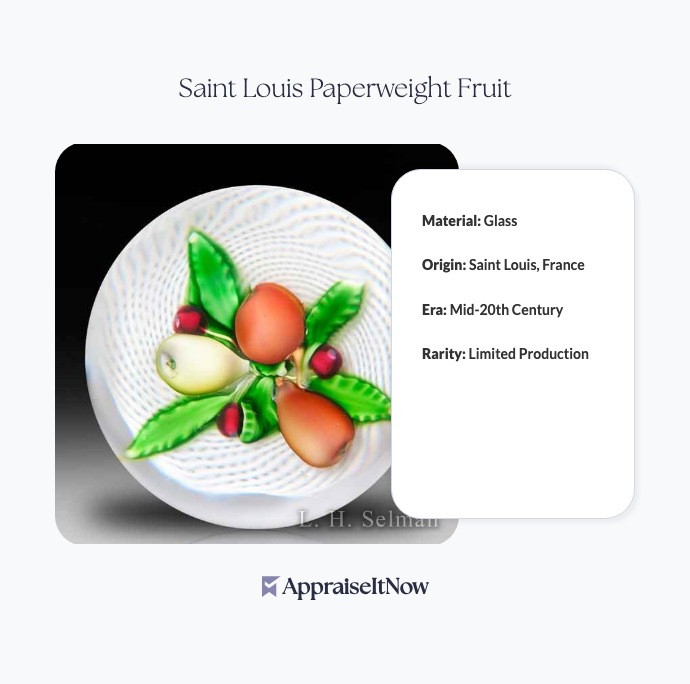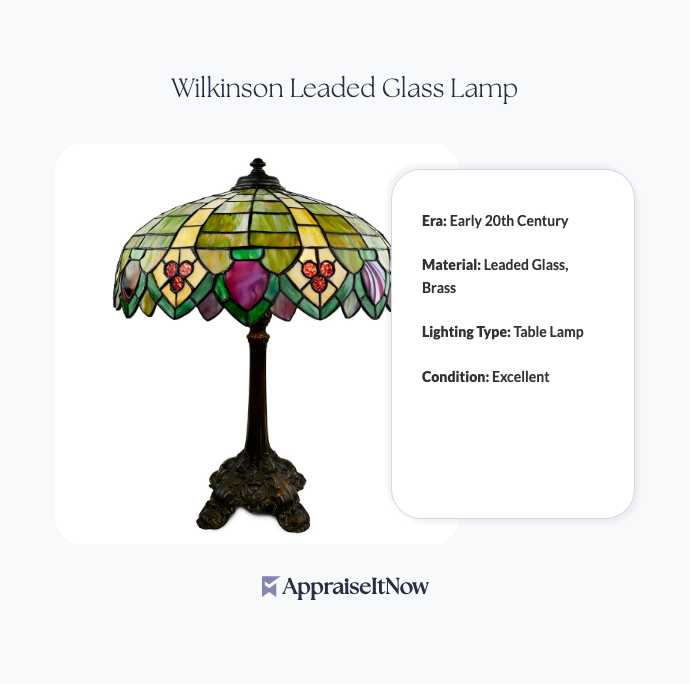<h1>How to Get Your Clichy Paperweight Rose Appraised</h1>
<p>A Clichy paperweight rose commands significant value in today's collectibles market, with estimates ranging from <strong>$4,000 to $6,000</strong> for quality examples. If you own one of these exquisite mid-19th century glass treasures, understanding how to get it properly appraised ensures you can confidently buy, sell, insure, or preserve your piece with accurate documentation and professional expertise.</p>
<h2>Understanding Clichy Paperweights and Their Value Drivers</h2>
<p>The Clichy glassworks in France produced some of the most sought-after paperweights ever created, and identifying a clichy paperweight requires knowledge of specific manufacturing characteristics that distinguish authentic pieces from later reproductions. First introduced in <strong>1860</strong>, these handcrafted examples feature intricately sculpted roses encased in clear glass, showcasing remarkable artisan skill that commands respect among serious collectors.</p>
<p>What makes a Clichy paperweight valuable? Several interconnected factors combine to establish the high appraisal values you see today. The <strong>limited production</strong> run means fewer examples exist compared to other Victorian-era paperweights. The <strong>vibrant colors</strong> achieved through Victorian-era glassmaking techniques often surpass those of contemporaries. The <strong>historical significance</strong> as luxury gift items for the European elite adds cultural weight to these pieces. And perhaps most importantly, the exceptional craftsmanship evident in every rose's delicate petals demonstrates artisan expertise that's impossible to replicate mechanically.</p>
<div class="callout tip"><p><strong>Collector's Insight</strong></p>
<p>Clichy roses with documented provenance from notable collections or estates can command premiums of 15-25% above standard market estimates.</p></div>
<h2>How to Identify Whether Your Paperweight is Valuable</h2>
<p>When you're wondering whether your paperweight is valuable, several characteristics help distinguish authentic Clichy pieces from lesser-quality examples or imitations. The most sought after paperweights share distinct visual and tactile qualities that professional appraisers evaluate systematically.</p>
<p>Authentic Clichy paperweights display clear, bubble-free glass of exceptional quality—a hallmark of their premium positioning among Victorian glassware. The rose itself features naturally graduated color transitions from deep crimson to lighter pink tones, created through layering techniques that were proprietary to Clichy's workshop. The base typically shows a distinctive flat-ground pontil mark where the glassmaker separated the finished piece from their working rod, and this mark's appearance helps establish authenticity and production era.</p>
<p>The weight and feel of your paperweight matter considerably. Clichy pieces are noticeably heavier than later reproductions due to their dense glass composition and larger volume. Hold your paperweight and notice how light refraction moves through the glass—genuine Clichy examples display exceptional clarity with minimal internal striations or cloudiness.</p>
<h2>Clichy Glass vs. Other Antique Paperweight Makers</h2>
<p>To evaluate your piece's standing in the broader collectibles market, understand how Clichy compares to other famous glass paperweight makers. The Victorian era saw paperweight production from multiple celebrated workshops, each with distinctive styles and values. Recognizing these differences helps appraisers and collectors contextualize pricing.</p>
<p>Clichy's primary competitors included Baccarat and Saint-Louis, both French glassworks producing high-quality examples. Baccarat paperweights typically feature more geometric pattern work with less botanical focus, while Saint-Louis examples often incorporate filigree elements and complex geometric designs. Clichy's particular strength lay in realistic botanical subjects—especially roses—that demonstrated unparalleled naturalism for the period. This specialization creates dedicated demand among collectors specifically seeking botanical examples, often supporting premium valuations compared to pattern-focused competitors.</p>
<p>The rarest vintage glass colors and styles from this era command exceptional prices. When collectors ask what is the rarest vintage glass color, the answer frequently involves Clichy's limited palette experiments from specific production years. Certain rose examples featuring unusual color combinations—deep burgundy, rare peachy tones, or unusually pale pink—may exceed standard valuations significantly.</p>
<div class="callout note"><p><strong>Market Context</strong></p>
<p>Among famous glass paperweight makers, Clichy distinguished itself through botanical artistry, making their rose examples particularly sought after by collectors worldwide.</p></div>
<h2>Determining Age and Authenticity</h2>
<p>Knowing how to tell how old a paperweight is requires examining multiple authentication markers that trained appraisers evaluate systematically. The manufacturing date of your Clichy rose falls within a specific window (generally <strong>1860-1890s</strong>), and certain characteristics help narrow the exact period.</p>
<p>The base quality and manufacturing technique provide temporal clues. Earlier Clichy examples feature slightly heavier bases with deliberate dimpling patterns, while later production shows smoother bases with more refined finishing. The glass composition itself evolved subtly over production decades—earlier pieces sometimes display marginally warmer color saturation while later examples show cooler, clearer tones.</p>
<p>Identifying clichy paperweight examples requires recognizing the workshop's characteristic "signature" within the piece itself. While Clichy rarely marked their paperweights overtly, the rose's structure, the glass's optical properties, and the base finishing all follow consistent patterns that distinguish them from other makers. Professional appraisers trained in differentiating among makers can identify Clichy pieces with high confidence based on these learned signatures.</p>
<h2>Why Professional Appraisal Matters for Your Clichy Rose</h2>
<p>Getting a professional appraisal of your Clichy paperweight rose serves multiple essential purposes beyond establishing monetary value. You gain certified documentation accepted by insurance companies, auction houses, estate attorneys, and financial institutions. Professional appraisers from AppraiseItNow provide USPAP-compliant valuations that stand up to legal and professional scrutiny.</p>
<p>A comprehensive appraisal includes detailed condition assessment, authentication verification, comparative market analysis, and photographic documentation. You'll receive a formal report explaining the specific factors supporting your piece's valuation—information invaluable for insurance purposes, sale negotiations, or estate planning. For collectors seeking to understand their investment's position within the broader <a href="/types/memorabilia-and-collectibles">memorabilia and collectibles</a> market, professional appraisals provide essential context.</p>
<p>When is professional appraisal particularly valuable for paperweights? Certainly when selling, but also when insuring. Many general homeowners' insurance policies limit coverage for collectibles to a few thousand dollars regardless of actual value. Documenting your $4,000-$6,000 Clichy rose with a professional appraisal ensures you can obtain <a href="/blog/how-to-properly-store-and-maintain-your-memorabilia-and-collectibles">specialized coverage</a> reflecting true replacement cost. Estate planning similarly requires documented valuations—whether dividing an estate among heirs or establishing the asset's significance for tax purposes.</p>
<div class="callout tip"><p><strong>Protection Strategy</strong></p>
<p>A professional appraisal documented with high-resolution photographs creates an irreplaceable record should your Clichy rose ever require insurance claim filing.</p></div>
<h2>What Appraisers Evaluate During Assessment</h2>
<p>Trained appraisers examining your Clichy paperweight rose consider specific characteristics that collectively establish market value. Understanding these evaluation points helps you prepare your piece and know what to expect during the appraisal process.</p>
<p><strong>Condition assessment</strong> forms the foundation of valuation. Appraisers examine your rose for chips, cracks, cloudiness, or internal bubbles—any damage reduces value substantially. A pristine example commands top-tier pricing within the $4,000-$6,000 range, while pieces showing wear or minor damage may assess lower. Surface condition matters too; dust or minor clouding from age is acceptable, but deep scratches or significant degradation affects value.</p>
<p><strong>Authenticity verification</strong> involves detailed examination distinguishing genuine Clichy pieces from reproductions. Appraisers look for consistent craftsmanship, appropriate glass characteristics, proper base finishing, and stylistic elements consistent with known Clichy production periods. Modern reproductions, while sometimes beautiful, carry dramatically lower values—often $100-$500—because they lack historical significance and collectibility appeal.</p>
<p><strong>Color analysis</strong> becomes particularly important for Clichy roses. The specific shade, saturation, and purity of the rose's coloring influence value. More saturated, naturally occurring colors typically command premiums. Unusual color variants, if verifiable as period production, may exceed standard valuations.</p>
<p><strong>Comparative market analysis</strong> contextualizes your piece within recent sales data. Appraisers reference sold comparables—similar Clichy paperweights that achieved documented prices at auction or private sale. This data-driven approach ensures your valuation reflects genuine market demand rather than arbitrary estimates. For comprehensive insights on this evaluation process, explore how professionals approach <a href="/blog/appraising-fine-glass-and-crystal-valuing-delicate-glassware-and-artistic-creations">appraising fine glass and crystal</a>.</p>
<h2>Specialized Knowledge Required for Proper Evaluation</h2>
<p>Why are paperweights so expensive, particularly examples from historic workshops like Clichy? The answer lies partly in scarcity, but also in the specialized knowledge required to properly evaluate them. Appraisers need training in Victorian-era glassmaking techniques, knowledge of different workshops' characteristic styles, and familiarity with the contemporary collectibles market.</p>
<p>This specialized expertise resembles that needed for evaluating <a href="/types/antique-artwork">fine art and antique artwork</a>. Just as trained art historians can authenticate paintings and establish provenance, paperweight specialists understand the subtle manufacturing signatures, historical contexts, and market dynamics that distinguish valuable examples from lesser pieces. When you hire an appraiser from AppraiseItNow, you're accessing experts with specific training in <a href="/blog/how-to-accurately-determine-the-value-of-your-memorabilia-and-collectibles">memorabilia and collectibles</a> valuation, ensuring accurate, credible assessments.</p>
<h2>Preparing Your Clichy Paperweight for Appraisal</h2>
<p>Before meeting with an appraiser, prepare your piece thoughtfully. Handle it minimally and avoid cleaning it yourself—professional conservators can assess whether gentle cleaning would enhance value or risk damage. Gather any documentation you possess: purchase receipts, previous appraisals, family histories, or exhibition records all strengthen your piece's provenance narrative.</p>
<p>Take preliminary photographs from multiple angles in good natural lighting, capturing the rose's color, base details, and any distinguishing marks. Document your piece's dimensions and weight if you have measurement tools. However, don't attempt to remove or examine the base too closely—this is the appraiser's domain, and careless handling risks damage.</p>
<div class="callout note"><p><strong>Preparation Tip</strong></p>
<p>Preserve any original packaging, documentation, or provenance materials alongside your paperweight. These supporting materials significantly enhance both value and appraisal credibility.</p></div>
<h2>Connecting with Qualified Appraisers</h2>
<p>When ready to pursue professional appraisal, AppraiseItNow offers streamlined access to credentialed experts across the United States. Our appraisers hold certifications from recognized professional organizations including AAA, ISA, ASA, CAGA, and AMEA—credentials indicating specialized training and commitment to ethical standards.</p>
<p>The appraisal process begins simply. You submit photographs, condition descriptions, and any available documentation through our secure platform. Our specialists review your submission and provide you with qualified appraisers who specialize in <a href="/blog/appraising-antiques-unveiling-the-hidden-treasures-in-your-collection">antique glassware and collectibles</a>. You'll receive comprehensive, USPAP-compliant documentation suitable for insurance, sale, or estate purposes.</p>
<p>Your Clichy paperweight rose represents a significant asset worthy of professional documentation. Whether you're preserving an inherited treasure, considering sale, or simply seeking to understand your collection's value, certified appraisal provides the expertise, credibility, and documentation that confident collectors require.</p>
<div class="callout note"><p><strong>Key Takeaway</strong></p>
<p>A certified appraisal of your Clichy paperweight rose ensures accurate valuation ($4,000-$6,000 for quality examples), proper authentication, and professional documentation essential for insurance coverage, sales transactions, or estate planning. AppraiseItNow connects you with specialized appraisers who understand the intricate factors that establish value for these extraordinary Victorian-era glass treasures.</p></div>







.avif)







